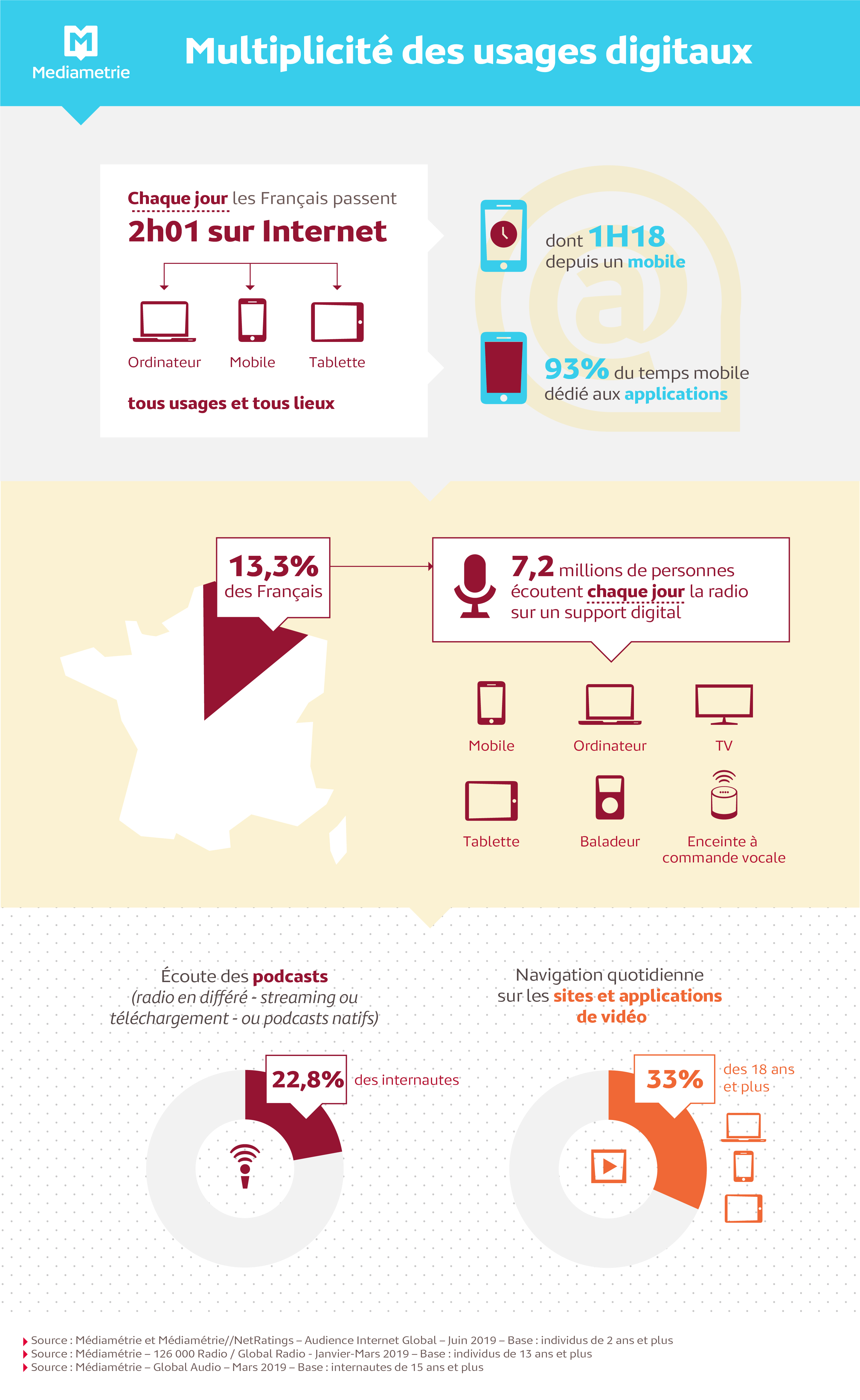The challenges of digital media planning

To address the complex nature of digital advertising formats, the market is looking to make its operations more transparent. Internet audience measurement and its corollary, internet media planning, have an essential role to play in this ecosystem. This article focuses on developments in this field.
A complex digital advertising ecosystem
Thanks to increased internet usage – with French people spending two hours per day on the internet, more than half of which is on mobile phones – and the sheer amount of content available, e.g. online media, podcasts and catch-up, etc., new opportunities have arisen for advertisers to promote their brands and for publishers to achieve monetisation. Therefore, digital media is playing an increasingly important role in advertising investment and offers a multitude of perpetually innovative formats. This abundance of formats primarily represents an opportunity for the various market players: the variety of advertising formats, accurate targeting, optimisation of campaigns. With this multitude of options, also comes increased complexity. On top of this complexity, there is the emergence of proprietary data, which – although it can provide added value – is not subject to any market convention or standard. Internet audience measurement must be able to play its advertising currency role and offer a neutral and independent reference.

Digital technologies have transformed the way in which the advertising ecosystem operates. In particular, ad servers are an essential link in the chain because they keep count of the marketed audiences. Although there are standards for calculating indicators such as impressions, by default, the data that they are based on is not subject to any verification or standard. The role of audience measurement and media planning is to offer a neutral and independent view of these operations. Upstream of a campaign, advertisers can predict the performance of their media plan. This is what is known as media planning. Once the campaign has been run, the measurement will certify the audience that was actually addressed; these are the Digital Ad Ratings campaign assessments.
For Julien Rosanvallon, Executive Director – Television and Internet at Médiamétrie, "The aim is to find an operation similar to the one for the TV or radio market, where the audience plays its currency role in full by bringing confidence and transparency to the exchanges. This is the key role of Médiamétrie's measurements."
Comparing advertising campaign forecasts and actual performance
In order to satisfy market players' requirements for transparency, the new media planning models must be more accurate, connected to advertising servers and consistent with campaign assessments. Médiamétrie's internet media planning, which is fed by the Total Internet Audience measurement, has a key role to play. Médiamétrie's Total Internet Audience measurement obtains its data from an internet panel of 25,000 individuals aged two years and older who are representative of the French population. The panel data is hybridised with site-centric data for exhaustive measurement across all three devices (computer, mobile, tablet) – sites and apps, regardless of the location, connection method (3G/4G/Wi-Fi), OS, operator or protocol (http/https).
Julien Rosanvallon added: “We have been working for many years to transform the planning and campaign assessment models so that they are coherent and connected to the ad-serving platforms."
This resulted in Médiamétrie developing an innovative methodology for its internet media planning which is based on a mathematical forecasting model (Markov model). With this model, media planning compares the forecasts with the actual performance of the campaign measured afterwards. This innovation was recognised at the IAB Europe Research Awards 2019 through the award of the "Highly Commended" prize by the panel in the Advertising Solutions category. This approach requires precise and granular campaign assessments. The Digital Ad Ratings (DAR) service – online advertising campaign audience measurement – is becoming the benchmark for a growing number of advertisers and agencies. This innovative solution combines panels and big data for a high degree of granularity and optimum representativity. Digital Ad Ratings (DAR) measures the daily coverage, repetition and on-target GRPs of online campaigns, across all devices (computer, smartphone, tablet).
Also, in order to continue to develop its planning tools, Médiamétrie is currently creating a nomenclature based on the advertising audience. This involves measuring the actual inventory of the sites by isolating the audience of the pages with advertising and adding new aggregates.
Moving towards connecting data to audience data
Finally, media planning requires increasingly precise target audiences based on the purchasing behaviour and practices of internet users. One answer to this is to connect the data collected by publishers to audience measurements. Médiamétrie's internet panel audiences can be used to establish target audiences based on internet practices according to the URLs that are visited by the panellists, e.g. prospective travel customers, people looking for bank loans, fashion/beauty, music. Other target audiences can be established based on the search data: they bring together a dictionary of key words associated with a theme and the corresponding URLs. Conversely, ad-serving platforms (via cookies) can be connected to the panels for use in media planning.
As part of a move aimed at unifying the measurement indicators for all formats, Médiamétrie has developed a video GRP. This integrates indicators on the exposure to advertising measures, namely the time spent and the visibility, allowing the actual qualification and comparison of exposure.
Laure Osmanian Molinero
3 questions for Jean-Damien Agurto, Head Of Digital & Data at the Initiative agency
What is your take on the digital advertising market and the various tools at your disposal for orchestrating campaigns ?
The development of programmatic advertising has reinforced the need to use measurement and media planning tools. Measurement tools have become an absolute necessity in our digital plans, particularly in terms of measurement of visibility and brand safety.
Also, it is from the regular use of these tools that the Ad Trust label has been established. This puts a heavy emphasis on the content quality and UX of sites. A number of studies also prove that an advertising format presence on premium content sites improves branding items much more than open exchange.
Combining these tools with the ones used to measure target reach gives our advertisers the opportunity to find out the real cost of a person belonging to their target audience who has been truly exposed to their advertising, which is something that no other medium is able to prove.
What do you use Médiamétrie's internet media planning for ? What does it offer you ?
We find the media planning tool useful in more ways than one. Firstly, it allows us to accurately estimate the coverage and repetition that we are likely to achieve with the media plan, and that can then be checked with our measurement tools.
Secondly, it allows us to decide between media or networks by calculating their duplication and their ability to grow in reach over a given period.
Finally, complementary studies such as Cibles + provide us with audience analyses that are not only based on sociodemographic criteria but also on purchasing behaviour data, which is something our clients particularly value.
What do you think the future requirements and developments will be in this market ?
Mobiles have now overtaken desktops in terms of usage which is evolving extremely rapidly. Media such as Tik Tok are able to emerge very quickly without measurement tools being able to adapt at the same speed. New levers such as digital audio and, in particular, podcasts have emerged without measurement tools having been able to adapt. This is of the priorities that needs to be worked on.
Drive-to-store measurement has also become just as crucial. Several technologies, with varying levels of accuracy, have emerged between bid requests, SDKs and beacons, meaning that agencies find it necessary to carry out their own testing to ensure accuracy. Regulation now needs to be put in place on this market to make this measurement more reliable.
Test of significance of the differences between two proportions
Used to assess whether the difference between 2 proportions is significant at the 95% threshold
Warning: only applies to a proportion. The Average Rate is an average of proportions and the Audience Share a ratio of proportions. This tool is provided for information purposes. It cannot be applied for professional purposes without further precautions.
des médias
edition
definitions